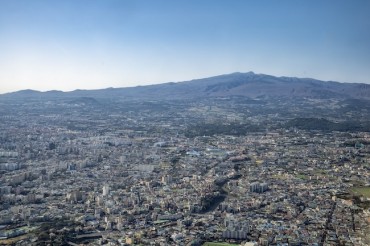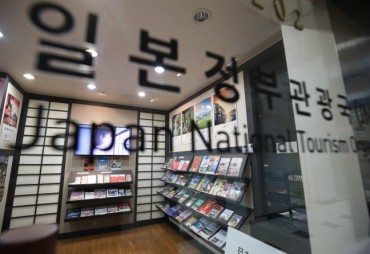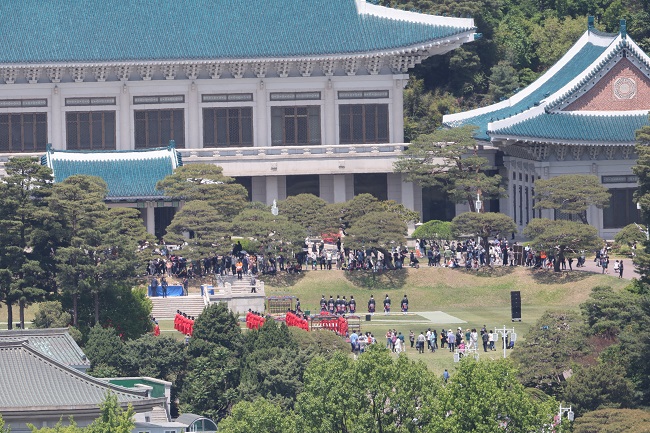
People look around Cheong Wa Dae in central Seoul, which has been South Korea’s presidential compound for the past 74 years, on May 10, 2022. (Pool photo) (Yonhap)
SEOUL, May 10 (Korea Bizwire) — Cheong Wa Dae was flooded with thousands of visitors Tuesday morning, the first day the former presidential office and residence fully opened to the public after new President Yoon Suk-yeol relocated the top office.
Following an opening ceremony, more than 6,000 people entered the compound in central Seoul at 11:38 a.m. to look around the 250,000-square-meter space, including the main office building and the residence that were used by South Korean presidents for the past 74 years, as well as gardens and the state guest house of Yeongbingwan.
Former President Moon Jae-in left the compound Monday after a five-year term.
“I am deeply moved that I am at a place that was used by South Korea’s presidents for decades,” Choi Chang-young, a 76-year-old from Bucheon, west of Seoul, said. “It was a good decision to open Cheong Wa Dae to the people.”
Another visitor, who identified herself only by her surname Yang, 21, said she wanted to be one of the first people to visit Cheong Wa Dae after its opening.
“I didn’t know it would be this cool. Cheong Wa Dae is much fancier and bigger than I had seen in textbooks and on the news,” Yang said, adding she is willing to visit the compound one more time when the insides of the buildings open to the public as well.
The insides of Cheong Wa Dae buildings are off-limits until after all sensitive equipment and documents are taken out.
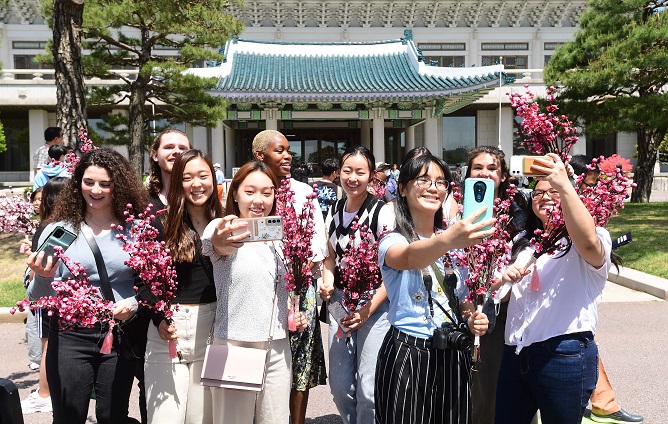
Foreign exchange students take a photo at Cheong Wa Dae in central Seoul, which has been South Korea’s presidential compound for the past 74 years, on May 10, 2022. (Pool photo) (Yonhap)
The visitors also included a 31-year-old North Korean defector, Kim Keum-hyok, who fled the North in 2012.
“In North Korea, all political power is covered in a veil and normal people cannot even approach the leader’s office. After watching people enjoy their time at Cheong Wa Dae, I hoped North Korea will open up more,” Kim said.
Foreigners were also among the visitors.
“Cheong Wa Dae is cooler than the White House,” Lukas Gatsby, a 23-year-old foreign exchange student from Chicago, said, holding apricot flowers handed out by the organizer for its floral meaning of “promise” in connection to Yoon’s pledge.
The full opening of Cheong Wa Dae came in accordance with Yoon’s election promise to relocate the presidential office out of Cheong Wa Dae and give the compound back to the public.
He said the move would help him connect better with the people as Cheong Wa Dae had become “a symbol of imperial power.”
Yoon began his term at midnight Monday at the new presidential office set up in the former defense ministry building in Seoul’s Yongsan district, several kilometers away from Cheong Wa Dae.
The defense ministry has moved to the nearby building used by the Joint Chiefs of Staff.
Cheong Wa Dae, situated at the foot of Mount Bukak behind Gyeongbok Palace, the main palace of the Joseon Dynasty (1392-1910), has been the venue of the presidential office and residence for the past 74 years after the South Korean government was established in 1948.
The compound, which covers about 250,000 square meters, or 62 acres, is 3.4 times larger than the White House.
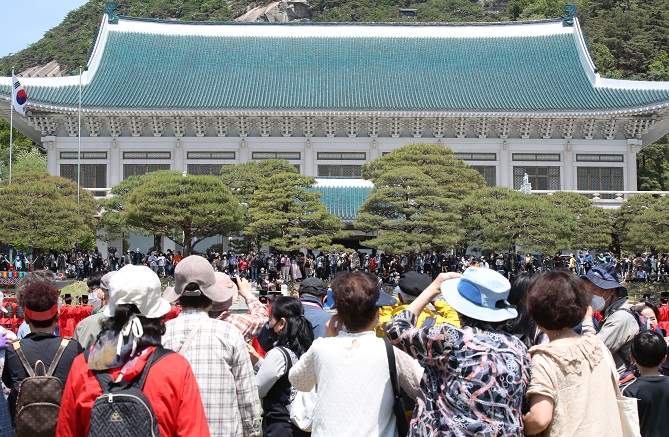
Visitors watch a performance in front of the main office building of former presidential compound Cheong Wa Dae in central Seoul on May 10, 2022. (Pool photo) (Yonhap)
The complex, also known as the Blue House, consists of the main office building, presidential residence, state reception house, press hall and secretariat buildings, among others.
Due to its secluded location and the substantial distances between the offices of the president, secretaries and the press, Cheong Wa Dae has long been criticized as a legacy of the “imperial presidency.”
The history of the Cheong Wa Dae site spans over 1,000 years, as it was home to royal palace halls during the Goryeo Dynasty (918-1392). It was then part of the rear garden for Gyeongbok Palace during the Joseon Dynasty.
During the Japanese colonial period from 1910 to 1945, the Japanese governor-general’s official residence was located there, while part of the Gyeongbok Palace grounds was used for the colonial government.
With the establishment of the South Korean government in 1948, then President Rhee Syng-man began to use the site as the presidential office and residence after naming it Gyeong Mu Dae.
It was renamed Cheong Wa Dae in 1960 after the inauguration of President Yun Bo-sun. For the next 62 years, Cheong Wa Dae has been used as a word that symbolizes supreme power.
Visits to Cheong Wa Dae will be allowed to people who have made online reservations in advance from 7 a.m. to 7 p.m. every day starting Wednesday, with a daily cap of 39,000 visitors per day and 6,500 visitors per two-hour time slot.
(Yonhap)




